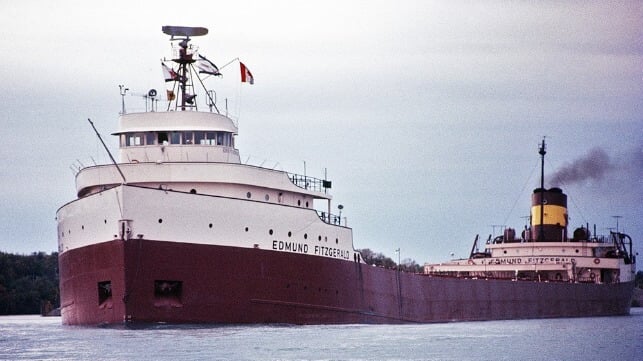50 Years Later, the Wreck of the Edmund Fitzgerald Remains a Mystery

November 10 marks the 50th anniversary of the wreck of the Edmund Fitzgerald, the most famous Great Lakes shipwreck and the most enduring mystery of the region's maritime lore.
Built in 1958, the 26,000 dwt Edmund Fitzgerald was the largest and fastest "laker" of her era. She carried taconite iron ore from mines near Duluth, Minnesota, to the iron works in Detroit, Toledo and other Great Lakes ports. The first lake freighter built to the maximum St. Lawrence Seaway size, she set half a dozen records for cargo volume per season.
Her tragic sinking occurred on a voyage from Superior, Wisconsin in late 1975. On November 9, Edmund Fitzgerald got under way with a full cargo of ore pellets with Captain Ernest M. McSorley in command, bound for a steel mill near Detroit. On November 10, the ship was caught in a severe storm on Lake Superior, with near hurricane-force winds and an estimated significant wave height of about 25 feet. At 1530 hours, Capt. McSorley radioed the nearby laker Arthur M. Andersen and reported that she was taking on water and had developed a list, following up at 1610 to report that Edmund Fitzgerald had lost both radars. Capt. McSorley's last received transmission - at 1910 hours - reported only that "we are holding our own." The vessel disappeared from radar contact, and no distress call was ever received; a search effort was mounted, but none of the crewmembers were found. The wreck site was located by the U.S. Navy, and an ROV dive investigation revealed that the ship had broken in two.
Many theories have been proposed for the reason behind the ship's loss, but none have marshalled enough evidence for agreement. The U.S. Coast Guard hypothesized that an ineffective hatch closure design allowed a hatch to leak, resulting in the gradual flooding of a cargo hold - an idea vigorously rejected by Great Lakes shipping operators. The National Transportation Safety Bureau reached a different conclusion: the weight of giant boarding seas crushed multiple hatch covers, resulting in sudden flooding. Others have suggested that the ship was hit by a set of unusually large waves, reported by the captain of the Andersen before her loss; or that Fitzgerald may have suffered hull damage in a brief grounding; or that the hull fractured and broke up in heavy wave action. None of these answers have been accepted as the definitive explanation for the sinking.
The Edmund Fitzgerald's loss was memorialized in song by Canadian performer Gordon Lightfoot the following year, making the mystery of the wreck a lasting popular phenomenon. Today, it is part of the cultural lore of the region and a source of interest for visitors. On the 50th anniversary of the sinking, multiple institutions held commemorative events to remember the 29 members of her crew. The National Museum of the Great Lakes in Toledo held a panel discussion, a tribute concert, ship tours on a similar laker, and a documentary screening; the Dossin Great Lakes Museum in Detroit hosted a book event and a commemorative ceremony for all those lost at sea in the Great Lakes over the years, including those aboard Fitzgerald. The Great Lakes Shipwreck Historical Society held a public remembrance service at Whitefish Point on Monday, and was so inundated with interest from news outlets that it politely advised all reporters that there would be "no more media requests," in order to "ensure a memorable and respectful ceremony."
Top image: SS Edmund Fitzgerald, 1971 (Greenmars / CC BY SA 3.0)
